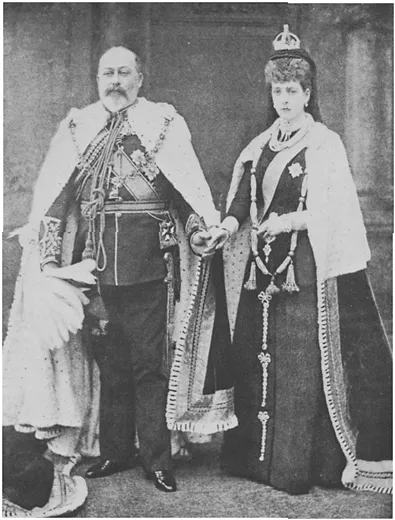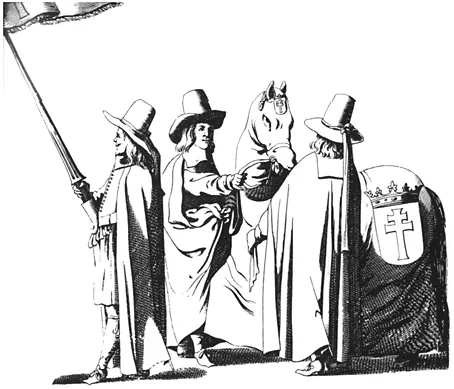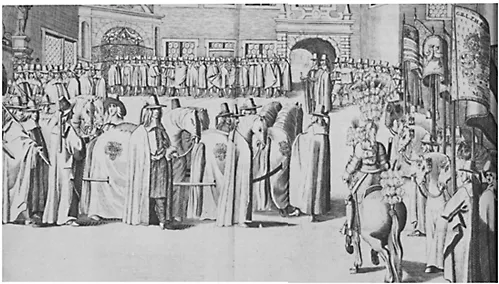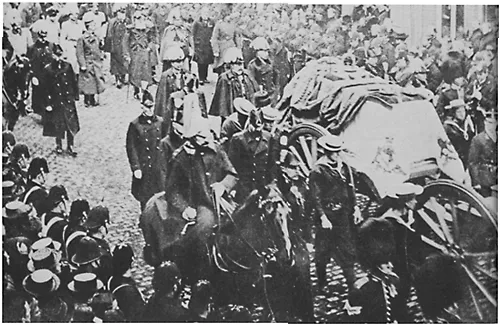
eBook - ePub
Mourning Dress (Routledge Revivals)
A Costume and Social History
Lou Taylor
This is a test
Condividi libro
- 326 pagine
- English
- ePUB (disponibile sull'app)
- Disponibile su iOS e Android
eBook - ePub
Mourning Dress (Routledge Revivals)
A Costume and Social History
Lou Taylor
Dettagli del libro
Anteprima del libro
Indice dei contenuti
Citazioni
Informazioni sul libro
First published in 1983, Mourning Dress chronicles the development of European and American mourning dress and etiquette from the middle ages to the present day, highlighting similarities and differences in practices between the different social strata. The result is a book which is not only of major importance to students of the history of dress but also to anyone who enjoys social history.
Domande frequenti
Come faccio ad annullare l'abbonamento?
È semplicissimo: basta accedere alla sezione Account nelle Impostazioni e cliccare su "Annulla abbonamento". Dopo la cancellazione, l'abbonamento rimarrà attivo per il periodo rimanente già pagato. Per maggiori informazioni, clicca qui
È possibile scaricare libri? Se sì, come?
Al momento è possibile scaricare tramite l'app tutti i nostri libri ePub mobile-friendly. Anche la maggior parte dei nostri PDF è scaricabile e stiamo lavorando per rendere disponibile quanto prima il download di tutti gli altri file. Per maggiori informazioni, clicca qui
Che differenza c'è tra i piani?
Entrambi i piani ti danno accesso illimitato alla libreria e a tutte le funzionalità di Perlego. Le uniche differenze sono il prezzo e il periodo di abbonamento: con il piano annuale risparmierai circa il 30% rispetto a 12 rate con quello mensile.
Cos'è Perlego?
Perlego è un servizio di abbonamento a testi accademici, che ti permette di accedere a un'intera libreria online a un prezzo inferiore rispetto a quello che pagheresti per acquistare un singolo libro al mese. Con oltre 1 milione di testi suddivisi in più di 1.000 categorie, troverai sicuramente ciò che fa per te! Per maggiori informazioni, clicca qui.
Perlego supporta la sintesi vocale?
Cerca l'icona Sintesi vocale nel prossimo libro che leggerai per verificare se è possibile riprodurre l'audio. Questo strumento permette di leggere il testo a voce alta, evidenziandolo man mano che la lettura procede. Puoi aumentare o diminuire la velocità della sintesi vocale, oppure sospendere la riproduzione. Per maggiori informazioni, clicca qui.
Mourning Dress (Routledge Revivals) è disponibile online in formato PDF/ePub?
Sì, puoi accedere a Mourning Dress (Routledge Revivals) di Lou Taylor in formato PDF e/o ePub, così come ad altri libri molto apprezzati nelle sezioni relative a Histoire e Histoire du monde. Scopri oltre 1 milione di libri disponibili nel nostro catalogo.
Informazioni
CHAPTER ONE
The Function and Ritual of European Funerals
CLOTHES mirror every nuance of the society in which they are worn, reflecting not only an individual’s aesthetic judgement but also his or her social standing and attitudes to society. Clothes also chronicle political and artistic upheavals. The study of dress, therefore, is a key which opens the door to a deeper understanding of the developments that take place in society and its social ambitions and aspirations.
Taste in dress is controlled by many factors and its functions, in whatever type of society it is worn, are many and varied, but basically clothes have been used from the earliest times as a means of clearly defining and enforcing the class divisions in society. They provide an ideal vehicle for displaying wealth and social status and sometimes for demonstrating political and religious convictions. This still applies today when anti-fashion is high fashion and secondhand clothes are as much a status symbol for the young as haute couture clothes are for the wealthy.
Women have always been used—nearly always with their own enthusiastic agreement and support—as a means of displaying their families’ rank. The ideal occasion for such a display was, and indeed still is, at public gatherings where expensive clothes could be seen by all. Ritual functions, such as the public ceremonies to mark birth, coming-of-age, marriage and death, provide a perfect setting for just such an open demonstration. The clothes worn on each of these occasions became and to some extent still are, highly elaborate and extravagant—far beyond the bounds of necessity and frequently in defiance of sumptuary laws. Babies were christened in full-length satin robes, with yards of lace hanging down below their toes, debutantes were presented at Court in Britain with ritualised, white, trained ball dresses, complete with tulle veils and white ostrich plumes. Brides or their parents still save up for months to provide the symbolic robes, full-length veils and orange blossom they will never wear again. For mourning a vast array of special clothing developed over the centuries, to be worn by the bereaved and particularly by widows. The study of fashionable European mourning dress provides us with an extraordinarily revealing insight into the functions of dress and the social position of women.
In order to appreciate the intricacies of mourning dress and to follow its stylistic evolution, it is necessary first to examine the development of European funeral ritual, which provided the public setting in which these clothes were worn. Funerals were an ideal stage for a public display of wealth and rank. Relatives were even able to improve their standing within their community by putting on an impressive and obviously costly funeral ceremony. This aspect of the death ritual grew to overshadow all others, until vast fortunes were being spent on grave offerings, mausoleums, funeral feasts and processions at royal and aristocratic funerals—as it was in ancient China and Egypt, so it became in Renaissance Europe. The rules of funeral etiquette became more and more intricate in a deliberate attempt to outmanoeuvre those further down the social ladder who could not hope to compete with all the expense. In Britain the gradual spread of funeral and mourning rituals from royal circles to the industrial working classes took about two hundred and fifty years, starting in the late sixteenth century and reflecting exactly the changing format of society and the rising aspirations of first the middle and then the working classes.
In Europe grandiose royal funerals only became possible when the heir to the throne was publicly declared and accepted before the death of the king. Before that time disorder and confusion reigned whilst the various hopeful aspirants to the Crown sought to establish their claims. Royal authority prevailed only after the king had been consecrated and crowned. Before that could occur the main concern of the heir apparent was to collect together his supporters and

1 King Edward VII and Queen Alexandra in April 1901, three months after the death of Queen Victoria, photographed at the State Opening of Parliament. Queen Alexandra is in deepest mourning. From The Sphere, 6 April 1901.
organise his own coronation. This left little time (and little money) for the arrangement of an elaborate funeral for his predecessor. On the death of William the Conqueror in 1080 the nobles fled the Court to their estates, leaving the servants to steal the dead king’s silver. The expenses of the simple royal funeral were paid for by the generosity of Herluin, one of William’s knights.1
Once immediate succession had been established, the way was paved for grandiose burials which symbolised the power and stability of the Crown—the more extravagant the better. The example was set in France when Philippe III carried his father’s body back from the Crusades in 1270–71 for a grand formal burial.2 Royal burials in France gradually developed into highly elaborate and lavish rituals which laid the foundations of mourning etiquette in Europe.
Ancient practices, including the offering of grave goods, funeral feasts and the wearing of special mourning clothes, were preserved in European Renaissance funeral traditions and survived until the nineteenth century. The offerings of expensive goods and foods, which had previously been placed in the grave, were, by the Renaissance period divided between the church, the king’s officers and other important officials who had taken part in the funeral cortège. Spoils from the funeral ceremonies included items such as coffin palls of cloth of gold, expensive wax tapers and royal horses. Protracted and bitter arguments took place between rival claimants. In 1422 the salt-carriers of Paris who carried the coffin of Charles IV claimed the cloth of gold pall, to the annoyance of the church authorities at the Abbey of St Denis, where all royal burials in France took place.3 After the funeral of Anne of Brittany in 1514 it took six years to settle all the disputed claims.4
The ancient custom of burying or burning the dead man’s horse, to transport his soul to the spirit world, was modified and the horses were instead led in the procession. In France after a grand funeral the horses were given to the church to help maintain the Crusader States. By the fourteenth century when the Holy Land had been lost horses were classified along with the wax candles and expensive black drapery, as part of the deceased’s offering to the church. At the funeral of François I in Paris in 1547 the parade horse or cheval d’honneur was covered ‘with a black crepe cloth, covering its royal purple trappings, leaving only the eyes visible.’5 In medieval and Tudor times in England one of the late king’s chargers was ridden up the nave of Westminster Abbey at his Requiem Mass, to be given to

2 Riderless horse at the funeral of George II, Landgrave of Hesse, Germany, 1661. An engraving by Adrien Schoonebeek.
the church at the door of the choir. The church benefice of giving away the horse had died out in France at the end of the fourteenth century, but the tradition of the dead man’s riderless horse following the coffin has survived, particularly in Britain. The Duke of Wellington’s funeral car was followed, in his great funeral procession of 1852, by his charger, complete with the Duke’s empty, dangling boots. The most recent examples have been seen at the funerals of the Duke of Norfolk at Arundel, Sussex on 5 February 1975 and at the State funeral of Lord Mountbatten in September 1979. Both the processions were led by riderless horses, which were hung with their owners’ riding boots, reversed in the stirrups.
The procedure for royal funeral processions was laid down in France by the fifteenth century. It was carefully copied in the nineteenth century and is still maintained at royal funerals today. Everyone remotely connected with the power of the Crown took part in the parade, those nearest the coffin being the most important or chief mourners. Until the late Middle Ages the successor to the deceased always took part in royal burials, but at the death of

3 Funeral procession of George II, Landgrave of Hesse, Germany, July 1661, based on French medieval etiquette. Engraved by Adrien Schoonebeek.

4 Funeral procession of Queen Victoria, 1901. The streets are lined with mourners—the women in hats, the men without them. From the Ladies Field, 2 February 1901.
François I in 1547 the new heir was forbidden to attend the ceremony and the future Henri II was obliged to watch the procession from a window on the Rue St Jacques. The Procureur-Général of the French Parliament, Jacques de la Guesle, explained in 1594 that, ‘It is not fitting to their [king’s] sacred persons to associate themselves with things funereal.’6 Chief mourners at royal funerals were, therefore, not the king’s heir but other royal princes and dukes.
Women played little part in grand funerals for men, although the chief mourner at the interment of an aristocratic woman was, originally, always a woman. Queen Elizabeth I’s coffin was followed by a ma...